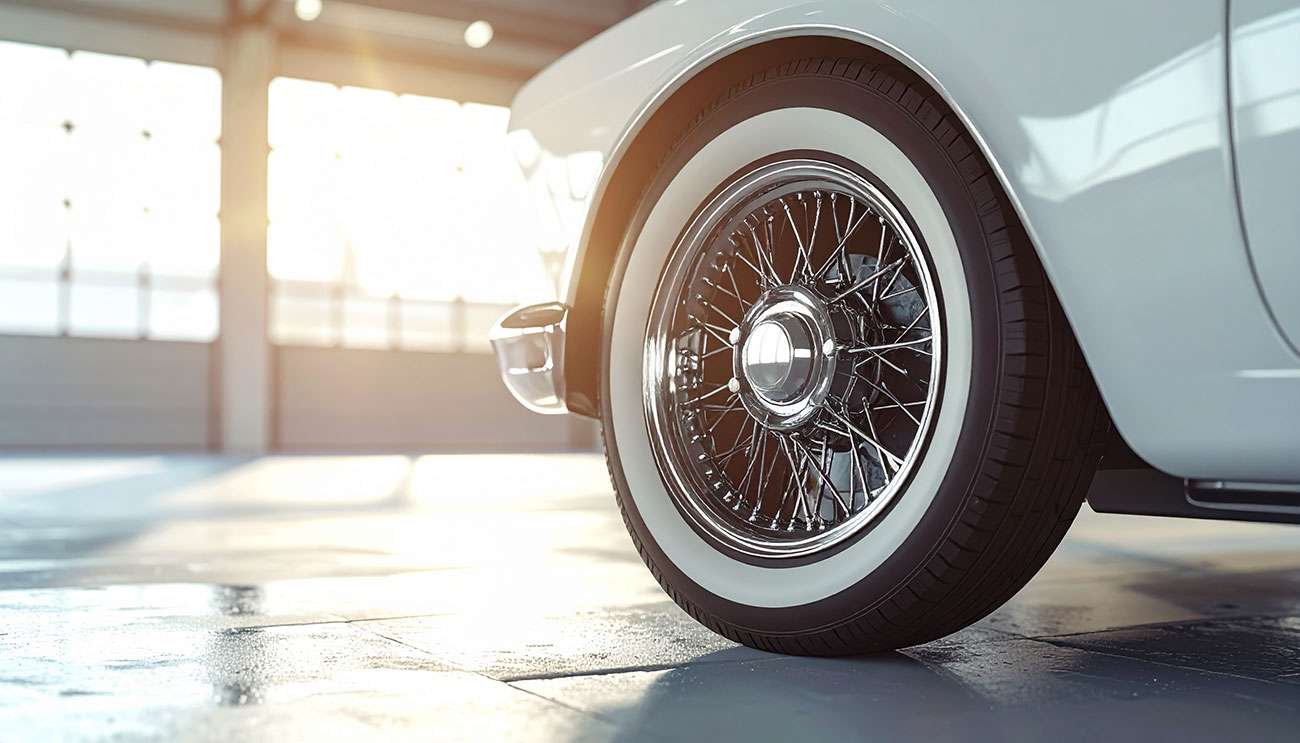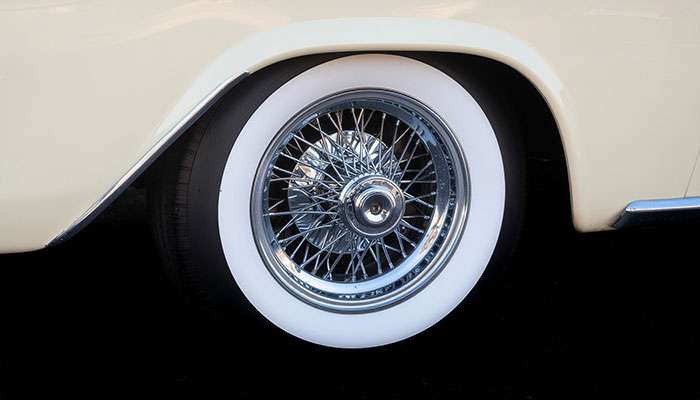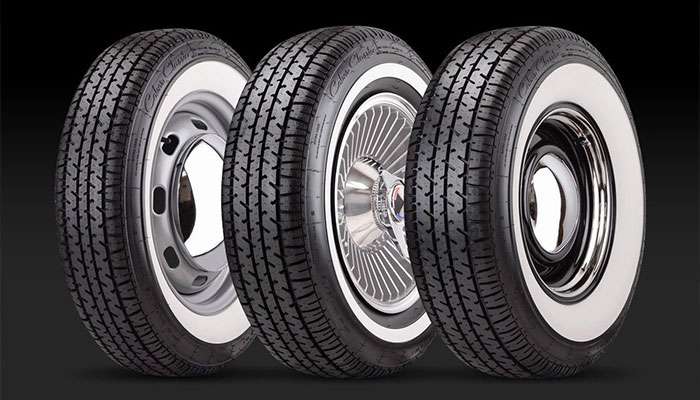
Whitewall tires command premium prices that often shock classic car enthusiasts. These distinctive tires originally served as luxury upgrades from standard blackwall tires, but today's cost difference has grown substantially beyond their historical premium. Modern whitewalls frequently cost two to three times more than comparable all-black tires.
The price gap stems from genuine manufacturing challenges that make these tires expensive to produce. White wall tires demand specialized compounds engineered to resist discoloration, since regular white materials simply won't maintain their appearance under normal driving conditions. Manufacturing volumes dropped dramatically when these tires transitioned from mainstream products to specialty items, spreading fixed costs across far fewer units. The production process remains stubbornly labor-intensive, requiring custom molds and specific materials that drive up the final price.
When Ford first offered whitewall tires as a factory option in 1934, they carried an $11.25 price tag—equivalent to $264 in today's money. These eye-catching tires gained popularity quickly, though supply shortages during World War II and the Korean War created availability challenges due to raw material restrictions.
We'll examine exactly why whitewall tires remain so expensive, exploring their unique manufacturing process, material requirements, and whether they're worth the investment for today's classic car owners.

The story of whitewall tires starts with a surprising twist—early automobile tires were never intended to make a fashion statement. All tires naturally displayed an off-white color because manufacturers used natural rubber without additives. Tire companies quickly learned that adding zinc oxide to their rubber compounds brightened the white appearance while boosting traction and durability.
These bright white tires created serious maintenance headaches before the 1910s. Vehicles navigating unpaved dirt roads would quickly turn pristine white tires into an unattractive beige mess. B.F. Goodrich changed everything in 1910 by introducing carbon black into tire compounds. This breakthrough additive dramatically improved rubber strength and longevity, making tires far more practical for daily use.
The transition to stronger black tires sparked an interesting development. Carbon black cost extra money, so smaller manufacturers applied it only to the tread area where durability mattered most. This cost-cutting strategy accidentally produced the first white sidewalls and black treads—an unplanned design that would become automotive history.
Harry Hower, a Chicago chauffeur working with luxury vehicles in 1914, gets credit for deliberately creating whitewall tires according to most historical accounts. His daily experience with high-end automobiles sparked a vision of how contrasting white and black tire designs could enhance luxury car appearance.
Hower teamed up with the Woodbury family, who already had tire business experience, to make his idea reality. They officially launched the Vogue Tire and Rubber Company by 1918. Margaret Woodbury, who later became Hower's wife, handled the marketing genius—naming the product "Vogue" and adding "Custom Built" to establish its premium status.
The distinctive appearance caught wealthy buyers' attention immediately. Loyd Dodson, a young Los Angeles entrepreneur, noticed Vogue tires on luxury cars during a Chicago trip and secured West Coast distribution rights by 1928. His smart strategy focused on Hollywood celebrities and Duesenberg owners, establishing whitewalls as the ultimate luxury accessory.
Whitewall tires evolved from exclusive luxury items to mainstream options throughout the 1930s. Ford made them an official factory option in 1934 at $11.25 per set. Popularity soared, though World War II and Korean War material shortages temporarily restricted availability.
The 1950s marked whitewalls' golden era, with wide white bands measuring approximately 3 inches. This peak began shrinking around 1954, as widths dropped to roughly 2.5 inches. Even premium models like the 1957 Cadillac Eldorado Brougham featured a narrower 1-inch white stripe positioned on the sidewall.
Everything changed in 1962 when manufacturers broadly eliminated wide whitewalls from regular production. The white bands kept shrinking—from 7/8-inch to 3/4-inch, then 5/8-inch and smaller. The 1970s saw these distinctive white bands virtually disappear from mainstream automotive design, though luxury models like Lincoln Continental maintained the look longer.
Classic car enthusiasts and automotive style lovers still appreciate these distinctive tires, keeping the elegant look of automotive's golden age alive today.
Whitewall tire manufacturing demands specialized techniques that standard tire production simply doesn't require. These distinctive tires can't roll off the same automated assembly lines used for conventional blackwall tires, creating production challenges that directly impact their final cost.
The process begins with precise preparation of different rubber compounds. Manufacturers must integrate a strip of white rubber during the early assembly stages, feeding this specialized material from dedicated equipment and positioning it exactly where the tire's sidewall will form. This critical step occurs well before the "green tire" (unvulcanized assembly) reaches the mold for final shaping.
Custom-designed molds made of steel or aluminum handle the curing process. These molds are exceptionally heavy, built to resist wear, and engineered specifically for each tire size, style, and brand. During curing, temperatures reach approximately 360 degrees Fahrenheit while steam inflates an internal bladder, forcing the hot rubber compound into every mold detail.
Creating the distinctive whitewall appearance requires careful blending of specialized rubber compounds. The white rubber must resist discoloration, since ordinary white materials quickly yellow or brown when exposed to environmental conditions.
Manufacturers face the challenge of precisely mixing white compound with adjacent black rubber to prevent color bleeding. The black portion contains carbon black, which strengthens the rubber, provides UV protection, and increases resistance to heat and abrasion. This material combination demands exact handling throughout every production stage.
Post-molding processing adds another layer of complexity. Each tire enters a special fixture where light abrasives carefully clean residue from the whitewall area. This finishing step requires exceptional precision, as minor imperfections result in immediate rejection.
Quality control standards for whitewalls exceed those of regular tires significantly. Every tire undergoes thorough inspection to ensure white sidewalls remain completely free of blemishes, stains, and inconsistencies. Visual defects often force manufacturers to reject or destroy entire shipments, substantially increasing production costs. Occasionally, slightly imperfect whitewalls are sold as "seconds," but this generates minimal profit.
Many whitewall production steps resist automation completely. As one manufacturer explains: "This is a labor-intensive process—you won't find any robots or automated process here".
Automation limitations stem primarily from visual inspection requirements and the delicate handling necessary for white sidewall areas. Modern tire factories have automated mixing, storage, transportation, and quality checks for standard tires. Yet whitewalls require human judgment for aesthetic quality that machines cannot effectively replicate.
The combination of specialized materials, additional manufacturing steps, stringent quality control, and limited automation creates the cost structure that makes whitewall tires considerably more expensive than standard alternatives.
The premium pricing for whitewall tires reflects real manufacturing costs and market economics, not simply inflated luxury pricing. Several factors drive these tires well beyond standard tire costs.
When whitewall tires shifted from mainstream options to specialty products, manufacturing economics changed dramatically. The transition from common products to specialty items reduced manufacturing quantities significantly. Production volumes dropped as these tires lost mainstream appeal, spreading fixed manufacturing costs across far fewer units.
Current whitewall tire pricing typically ranges from $150 to $180 per tire, with premium manufacturers like Coker and Diamond Back commanding $280-$435 depending on size and whitewall width. Budget-conscious classic car owners can find more affordable alternatives like the Hankook Optimo H724 ($56-$152) and Uniroyal Tiger Paw AWP II ($133 per tire).
Manufacturing whitewall tires demands custom equipment that standard tire production doesn't require. Heavy steel or aluminum molds must be custom-made for each tire size, style, and brand. These molds need exceptional wear resistance while producing delicate visual details. Manufacturers also develop special white rubber compounds that resist discoloration, typically costing more than standard materials.
Quality control standards create the biggest cost factor for whitewall production. These tires must remain visually perfect—completely free from blemishes, stains, or inconsistencies. High rejection rates result when entire shipments fail visual standards and require destruction. Tires with minor imperfections sold as "seconds" generate minimal profit.
Genuine whitewall tires cost substantially more than blackwall counterparts for four specific reasons:
Additional manufacturing steps developed in the 1920s
Labor-intensive processes that resist automation
Specialized quality control requirements
Lower production volumes spreading fixed costs
Find the best selection of Whitewall Tires at Performance Plus Tire, which offers everything from budget-friendly options to premium reproductions that maintain the highest standards of authenticity for classic car enthusiasts.
Demand for these distinctive tires comes primarily from classic car enthusiasts and collectors, requiring manufacturers to balance traditional construction methods with modern performance expectations.
Understanding whitewall tires means acknowledging their maintenance demands, which directly impact your long-term ownership costs. These distinctive tires face durability challenges that standard blackwall tires simply don't encounter.
Those pristine white sidewalls won't stay pristine without consistent effort. The main culprit behind discoloration comes from antiozonant compounds that manufacturers add to prevent premature aging and dry rot. While these compounds protect the rubber from deterioration, they cause brown staining when exposed to oxygen. Even properly stored whitewalls will eventually develop yellow or brown discoloration from normal atmospheric exposure.
This discoloration issue goes beyond appearance—it reflects a fundamental material weakness. Pure white rubber lacks the durability of carbon black compounds, making whitewalls more susceptible to scuffing, staining, and environmental damage.
Maintaining whitewalls demands specialized products and regular attention. Tire care experts recommend cleaning these tires every two weeks to prevent permanent discoloration. You must choose cleaning products carefully, as many common solutions create more problems than they solve.
Bleach and alcohol might brighten whitewalls initially, but these harsh chemicals accelerate yellowing by stripping away protective conditioners and UV protectants. Commercial cleaners containing acids or ammonia can remove dirt while simultaneously damaging the rubber structure. Gentle whitewall-specific formulations that remove oxidized antiozonant without degrading the rubber offer the safest cleaning approach.
Blackwall tires clearly outperform whitewalls when it comes to maintenance simplicity. They don't readily show dirt, scuffs, or environmental staining. Their carbon black compounds provide superior resistance to UV damage, heat, and abrasion.
Unlike whitewalls, blackwall tires rarely need specialized cleaning products or techniques. Most owners can maintain them with standard car wash soap without worrying about discoloration or specialized care routines. This maintenance advantage represents a key factor in why blackwall tires became the industry standard, offering better durability, safety, and lower lifetime costs.

Image Source: Fuel Curve
Whitewall tires haven't vanished from the marketplace despite their departure from mainstream automotive production. Several specialty manufacturers continue producing these iconic tires for enthusiasts who value their distinctive appearance.
Whitewall tires remain available through specialized manufacturers who focus on the restoration and classic car markets. Coker Tire, Vogue Tire, Diamond Back Classic, and American Classic maintain dedicated whitewall production lines. These companies use improved manufacturing techniques while preserving authentic styling characteristics. Major tire retailers like Discount Tire also stock select whitewall options from Cooper, Hankook, Milestar, and Uniroyal.
Classic car enthusiasts and collectors represent the primary market for whitewall tires today. These tires are especially popular for vehicles manufactured from the 1920s through the 1980s. Restored classics, custom builds, and lowriders frequently feature whitewalls to achieve period-correct appearance.
Today's whitewall buyers face a choice between historically accurate bias-ply construction or modern radial construction. Bias-ply whitewalls deliver authentic ride characteristics for pre-1970s vehicles, while radial whitewalls provide better handling, traction, and safety for classics driven regularly. Coker's "bias look" radials offer an interesting compromise, combining vintage appearance with modern performance benefits.
Alternatives to genuine whitewalls include portawalls (removable inserts between tire and rim), adhesive decals, and custom tires with ground sidewalls. These imitation options cost less but don't match the durability and safety of properly manufactured whitewalls.
Find the best selection of Whitewall Tires at Performance Plus Tire for everything from budget-friendly options to premium reproductions.
Whitewall tires represent more than just automotive history—they're a statement of style and authenticity that classic car enthusiasts understand. From their accidental creation to their 1950s golden age, these distinctive tires have maintained their appeal despite practical challenges and premium pricing.
The substantial price difference between whitewalls and standard blackwall tires reflects genuine manufacturing realities. The specialized production process remains labor-intensive and resistant to automation, while low production volumes, custom molds, and specialized materials drive costs significantly higher. Stringent quality control standards further increase expenses, as manufacturers often reject entire shipments for minor visual imperfections.
Maintenance requirements add another layer of ownership costs. The white rubber compounds naturally discolor from antiozonant chemicals necessary for durability, requiring regular cleaning with specialized products to maintain that pristine appearance. This ongoing commitment makes whitewalls impractical for daily drivers but worthwhile for dedicated classic car owners.
Today's specialty manufacturers like Coker, Vogue, and Diamond Back continue producing these iconic tires for enthusiasts who value authenticity. Whether you choose historically accurate bias-ply construction or modern radials with vintage styling, options exist for every restoration project and budget.
For classic car owners seeking period-correct appearance, whitewalls offer irreplaceable value. They capture the essence of automotive's golden age when craftsmanship and style took precedence over pure practicality. The extra cost and maintenance become worthwhile investments when they complete the authentic look of a cherished classic.
Find the best selection of Whitewall Tires at Performance Plus Tire, where we offer everything from budget-friendly options to premium reproductions that meet the highest standards of authenticity for discerning classic car enthusiasts.
Understanding why whitewall tires command premium prices reveals the intersection of automotive history, specialized manufacturing, and niche market dynamics that classic car enthusiasts should consider.
Labor-intensive manufacturing drives costs up - Whitewall production requires specialized molds, custom compounds, and manual quality control that resists automation, making them significantly more expensive than standard tires.
Low production volumes create premium pricing - As whitewalls transitioned from mainstream to specialty products, reduced manufacturing quantities spread fixed costs across fewer units, dramatically increasing per-tire expenses.
High maintenance requirements add hidden costs - White rubber naturally discolors from antiozonant compounds and requires specialized cleaning products every two weeks to prevent permanent yellowing and staining.
Quality control standards increase rejection rates - Stringent visual inspection requirements lead to high rejection rates for blemishes or imperfections, with entire shipments sometimes destroyed, further inflating costs.
Modern options balance authenticity with performance - Today's specialty manufacturers offer both historically accurate bias-ply tires and modern radial construction with vintage styling for classic car restoration projects.
While whitewall tires remain a niche luxury primarily for classic car enthusiasts, their enduring appeal demonstrates how automotive heritage and craftsmanship continue to command premium prices in specialized markets.
Whitewall tires are more expensive due to their specialized manufacturing process, which involves custom molds, specific materials, and labor-intensive assembly. The low production volume and high rejection rates for visual imperfections also contribute to their higher cost.
Yes, whitewall tires are still available today. Specialty manufacturers like Coker Tire, Vogue Tire, and Diamond Back Classic continue to produce them for classic car enthusiasts and collectors. Some major tire retailers also offer select whitewall options from various brands.
Whitewall tires require more maintenance than standard tires due to their tendency to discolor and stain. The white rubber is prone to yellowing from exposure to antiozonant compounds, necessitating regular cleaning with specialized products to maintain their pristine appearance.
Whitewall tires began to decline in popularity in the early 1960s. By 1962, wide whitewalls were largely phased out of regular production options. The trend continued through the 1970s, with the distinctive white band essentially disappearing from mainstream automotive design.
Today, whitewall tires are primarily used on classic cars, especially those from the 1920s through the 1980s. They are popular among car enthusiasts for restored classics, custom builds, and lowriders seeking a period-correct appearance. Some luxury models may also feature whitewall tires for a vintage esthetic.